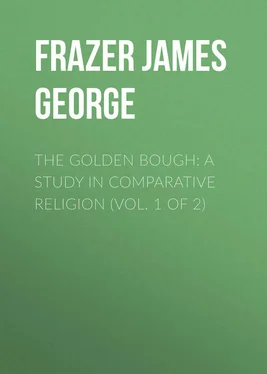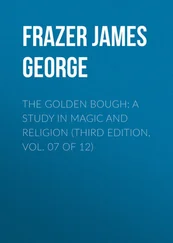James Frazer - The Golden Bough - A Study in Comparative Religion (Vol. 1 of 2)
Здесь есть возможность читать онлайн «James Frazer - The Golden Bough - A Study in Comparative Religion (Vol. 1 of 2)» — ознакомительный отрывок электронной книги совершенно бесплатно, а после прочтения отрывка купить полную версию. В некоторых случаях можно слушать аудио, скачать через торрент в формате fb2 и присутствует краткое содержание. Жанр: foreign_religion, foreign_antique, foreign_prose, на английском языке. Описание произведения, (предисловие) а так же отзывы посетителей доступны на портале библиотеки ЛибКат.
- Название:The Golden Bough: A Study in Comparative Religion (Vol. 1 of 2)
- Автор:
- Жанр:
- Год:неизвестен
- ISBN:нет данных
- Рейтинг книги:4 / 5. Голосов: 1
-
Избранное:Добавить в избранное
- Отзывы:
-
Ваша оценка:
- 80
- 1
- 2
- 3
- 4
- 5
The Golden Bough: A Study in Comparative Religion (Vol. 1 of 2): краткое содержание, описание и аннотация
Предлагаем к чтению аннотацию, описание, краткое содержание или предисловие (зависит от того, что написал сам автор книги «The Golden Bough: A Study in Comparative Religion (Vol. 1 of 2)»). Если вы не нашли необходимую информацию о книге — напишите в комментариях, мы постараемся отыскать её.
The Golden Bough: A Study in Comparative Religion (Vol. 1 of 2) — читать онлайн ознакомительный отрывок
Ниже представлен текст книги, разбитый по страницам. Система сохранения места последней прочитанной страницы, позволяет с удобством читать онлайн бесплатно книгу «The Golden Bough: A Study in Comparative Religion (Vol. 1 of 2)», без необходимости каждый раз заново искать на чём Вы остановились. Поставьте закладку, и сможете в любой момент перейти на страницу, на которой закончили чтение.
Интервал:
Закладка:
In the class of cases of which the above are specimens it is obvious that the leaf-clad person who is led about is equivalent to the May-tree, May-bough, or May-doll, which is carried from house to house by children begging. Both are representatives of the beneficent spirit of vegetation, whose visit to the house is recompensed by a present of money or food.
Often the leaf-clad person who represents the spirit of vegetation is known as the king or the queen; thus, for example, he or she is called the May King, Whitsuntide King, Queen of May, and so on. These titles, as Mannhardt observes, imply that the spirit incorporate in vegetation is a ruler, whose creative power extends far and wide. 314 314 Mannhardt, B. K. p. 341 sq.
In a village near Salzwedel a May-tree is set up at Whitsuntide and the boys race to it; he who reaches it first is king; a garland of flowers is put round his neck and in his hand he carries a May-bush, with which, as the procession moves along, he sweeps away the dew. At each house they sing a song, wishing the inmates good luck, referring to the “black cow in the stall milking white milk, black hen on the nest laying white eggs,” and begging a gift of eggs, bacon, etc. 315 315 Kuhn und Schwartz, Norddeutsche Sagen, Märchen und Gebräuche , p. 380.
In some villages of Brunswick at Whitsuntide a May King is completely enveloped in a May-bush. In some parts of Thüringen also they have a May King at Whitsuntide, but he is got up rather differently. A frame of wood is made in which a man can stand; it is completely covered with birch boughs and is surmounted by a crown of birch and flowers, in which a bell is fastened. This frame is placed in the wood and the May King gets into it. The rest go out and look for him, and when they have found him they lead him back into the village to the magistrate, the clergyman, and others, who have to guess who is in the verdurous frame. If they guess wrong, the May King rings his bell by shaking his head, and a forfeit of beer or the like must be paid by the unsuccessful guesser. 316 316 Kuhn und Schwartz, op. cit. p. 384; Mannhardt, B. K. p. 342.
In some parts of Bohemia on Whit-Monday the young fellows disguise themselves in tall caps of birch bark adorned with flowers. One of them is dressed as a king and dragged on a sledge to the village green, and if on the way they pass a pool the sledge is always overturned into it. Arrived at the green they gather round the king; the crier jumps on a stone or climbs up a tree and recites lampoons about each house and its inmates. Afterwards the disguises of bark are stripped off and they go about the village in holiday attire, carrying a May-tree and begging. Cakes, eggs, and corn are sometimes given them. 317 317 Reinsberg-Düringsfeld, Fest-Kalendar aus Böhmen , p. 260 sq. ; Mannhardt, B. K. p. 342 sq.
At Grossvargula, near Langensalza, in last century a Grass King used to be led about in procession at Whitsuntide. He was encased in a pyramid of poplar branches, the top of which was adorned with a royal crown of branches and flowers. He rode on horseback with the leafy pyramid over him, so that its lower end touched the ground, and an opening was left in it only for his face. Surrounded by a cavalcade of young fellows, he rode in procession to the town hall, the parsonage, etc., where they all got a drink of beer. Then under the seven lindens of the neighbouring Sommerberg, the Grass King was stripped of his green casing; the crown was handed to the Mayor, and the branches were stuck in the flax fields in order to make the flax grow tall. 318 318 Mannhardt, B. K. p. 347 sq. ; Witzschel, Sagen, Sitten und Gebräuche aus Thüringen , p. 203.
In this last trait the fertilising influence ascribed to the representative of the tree-spirit comes out clearly. In the neighbourhood of Pilsen (Bohemia) a conical hut of green branches, without any door, is erected at Whitsuntide in the midst of the village. To this hut rides a troop of village lads with a king at their head. He wears a sword at his side and a sugar-loaf hat of rushes on his head. In his train are a judge, a crier, and a personage called the Frog-flayer or Hangman. This last is a sort of ragged merryandrew, wearing a rusty old sword and bestriding a sorry hack. On reaching the hut the crier dismounts and goes round it looking for a door. Finding none, he says, “Ah, this is perhaps an enchanted castle; the witches creep through the leaves and need no door.” At last he draws his sword and hews his way into the hut, where there is a chair, on which he seats himself and proceeds to criticise in rhyme the girls, farmers, and farm-servants of the neighbourhood. When this is over, the Frog-flayer steps forward and, after exhibiting a cage with frogs in it, sets up a gallows on which he hangs the frogs in a row. 319 319 Reinsberg-Düringsfeld, Fest-Kalendar aus Böhmen , p. 253 sqq.
In the neighbourhood of Plas the ceremony differs in some points. The king and his soldiers are completely clad in bark, adorned with flowers and ribbons; they all carry swords and ride horses, which are gay with green branches and flowers. While the village dames and girls are being criticised at the arbour, a frog is secretly pinched and poked by the crier till it quacks. Sentence of death is passed on the frog by the king; the hangman beheads it and flings the bleeding body among the spectators. Lastly, the king is driven from the hut and pursued by the soldiers. 320 320 Reinsberg-Düringsfeld, Fest-Kalendar aus Böhmen , p. 262; Mannhardt, B. K. p. 353 sq.
The pinching and beheading of the frog are doubtless, as Mannhardt observes, 321 321 B. K. p. 355.
a rain-charm. We have seen 322 322 Above, p. 18 .
that some Indians of the Orinoco beat frogs for the express purpose of producing rain, and that killing a frog is a German rain-charm.
Often the spirit of vegetation in spring is represented by a queen instead of a king. In the neighbourhood of Libchowic (Bohemia), on the fourth Sunday in Lent, girls dressed in white and wearing the first spring flowers, as violets and daisies, in their hair, lead about the village a girl who is called the Queen and is crowned with flowers. During the procession, which is conducted with great solemnity, none of the girls may stand still, but must keep whirling round continually and singing. In every house the Queen announces the arrival of spring and wishes the inmates good luck and blessings, for which she receives presents. 323 323 Reinsberg-Düringsfeld, Fest-Kalendar aus Böhmen , p. 93; Mannhardt, B. K. p. 344.
In German Hungary the girls choose the prettiest girl to be their Whitsuntide Queen, fasten a towering wreath on her brow, and carry her singing through the streets. At every house they stop, sing old ballads, and receive presents. 324 324 Mannhardt, B. K. p. 343 sq.
In the south-east of Ireland on May Day the prettiest girl used to be chosen Queen of the district for twelve months. She was crowned with wild flowers; feasting, dancing, and rustic sports followed, and were closed by a grand procession in the evening. During her year of office she presided over rural gatherings of young people at dances and merrymakings. If she married before next May Day her authority was at an end, but her successor was not elected till that day came round. 325 325 Dyer, British Popular Customs , p. 270 sq.
The May Queen is common in France 326 326 Mannhardt, B. K. p. 344 sq. ; Cortet, Fêtes religieuses , p. 160 sqq. ; Monnier, Traditions populaires comparées , p. 282 sqq. ; Bérenger-Féraud, Réminiscences populaires de la Provence , p. 1 sqq.
and familiar in England.
Again the spirit of vegetation is sometimes represented by a king and queen, a lord and lady, or a bridegroom and bride. Here again the parallelism holds between the anthropomorphic and the vegetable representation of the tree-spirit, for we have seen above that trees are sometimes married to each other. 327 327 Above, p. 60 .
In a village near Königgrätz (Bohemia) on Whit-Monday the children play the king's game, at which a king and a queen march about under a canopy, the queen wearing a garland, and the youngest girl carrying two wreaths on a plate behind them. They are attended by boys and girls called groom's men and bridesmaids, and they go from house to house collecting gifts. 328 328 Reinsberg-Düringsfeld, Fest-Kalendar aus Böhmen , p. 265 sq. ; Mannhardt, B. K. p. 422.
Near Grenoble, in France, a king and queen are chosen on the 1st of May and are set on a throne for all to see. 329 329 Monnier, Traditions populaires comparées , p. 304; Mannhardt, B. K. p. 423.
At Headington, near Oxford, children used to carry garlands from door to door on May Day. Each garland was carried by two girls, and they were followed by a lord and lady – a boy and girl linked together by a white handkerchief, of which each held an end, and dressed with ribbons, sashes, and flowers. At each door they sang a verse —
Интервал:
Закладка:
Похожие книги на «The Golden Bough: A Study in Comparative Religion (Vol. 1 of 2)»
Представляем Вашему вниманию похожие книги на «The Golden Bough: A Study in Comparative Religion (Vol. 1 of 2)» списком для выбора. Мы отобрали схожую по названию и смыслу литературу в надежде предоставить читателям больше вариантов отыскать новые, интересные, ещё непрочитанные произведения.
Обсуждение, отзывы о книге «The Golden Bough: A Study in Comparative Religion (Vol. 1 of 2)» и просто собственные мнения читателей. Оставьте ваши комментарии, напишите, что Вы думаете о произведении, его смысле или главных героях. Укажите что конкретно понравилось, а что нет, и почему Вы так считаете.












